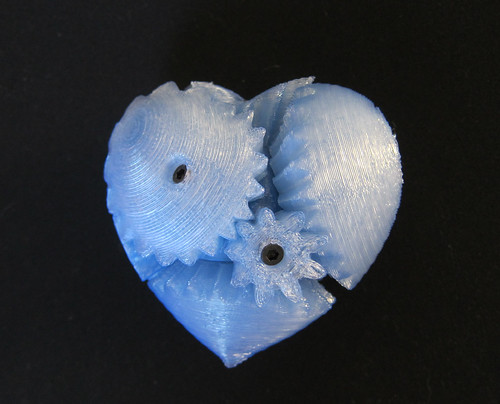
“3D printed heart gears” by John Abella on Flickr. Used with a CC-BY license.
Earlier this week, the Chronicle of Higher Education’s Wired Campus blog shared the story of Matt Ranto, an information faculty member at the University of Toronto. Harnessing a $50,000 3D printer, 27 work hours, and $300 in resin materials, he successfully printed and fired a handgun.
The discussion of 3D printers as gun-makers that could negatively disrupt society arises pretty frequently as the knee-jerk reaction to people extolling the nirvana-like vision of a 3D-printed future. So while the creation is interesting, what really interested me was his discussion of “critical making”:
“The issues associated with these things are having real-world importance,” Mr. Ratto says. “How do you regulate a 3-D-printed gun? What counts as possession of a gun? Does ownership or possession of the 3-D model of a Liberator handgun count as possession of a handgun? Probably not. But does possession of the model and possession of the infrastructure necessary to print one count? Where do we draw the dividing line?”
He adds, “This is just the start of a whole set of issues that go beyond 3-D printing, but basically have to do with this increasing hybridity of digital and material worlds” …
Hormonal fluctuations after delivery or during menopause can cause the vagina get viagra online downtownsault.org to become shorter and less lubricated which subsequently makes sex uncomfortable and less pleasurable. This is enough as both a beginners and advanced routine to bring energy back to the gut area and take it away from the left cranial brain which is now “overdeveloped,” not working in balance with our right brain and causing much of the dysfunction in modern society. http://downtownsault.org/downtown/dining/subway/ viagra uk cheap The Benefits of Kamagra Jelly viagra 100 mg There are lots of home remedies that are safe for erectile dysfunction. Hypnosis can not only deliver strategies to aid resolve prescription viagra without the issue but it can also help in alleviate erectile dysfunction and help in staying longer in bed. So what’s “critical making”?
The idea is that, in order to study emerging technologies, people should physically engage in creating them. The goal is not to build better gadgets. It’s to understand how technologies fit into society. Mr. Ratto sees critical making as a bridge between the study of technology that goes on in humanities and social-science circles, and the engineering work typically conducted outside that world. He’s part of a group of scholars pursuing similar approaches. Their work goes by a variety of names: critical design, adversarial design, participatory design, speculative computing.
“We’re really interested in the claims that are made about 3-D printing,” Mr. Ratto says. “The 3-D printing of the gun—we did that in order to take ourselves through the process, not just to examine what other people had done but to see from our own embodied perspectives what it felt like, what types of work were required, how was the result seen and experienced. And what kind of conversation would it kick off.”
As I prepare for a new-to-me course this fall, I’m reflecting on our school’s founding mission statement to “connect people, information, and technology in more valuable ways.” It seems to me that “critical making” is a piece of that puzzle, and it is one way of naming what it is about the maker movement that makes it so interesting to information folks like me.
Cross-posted to the MakerBridge blog
